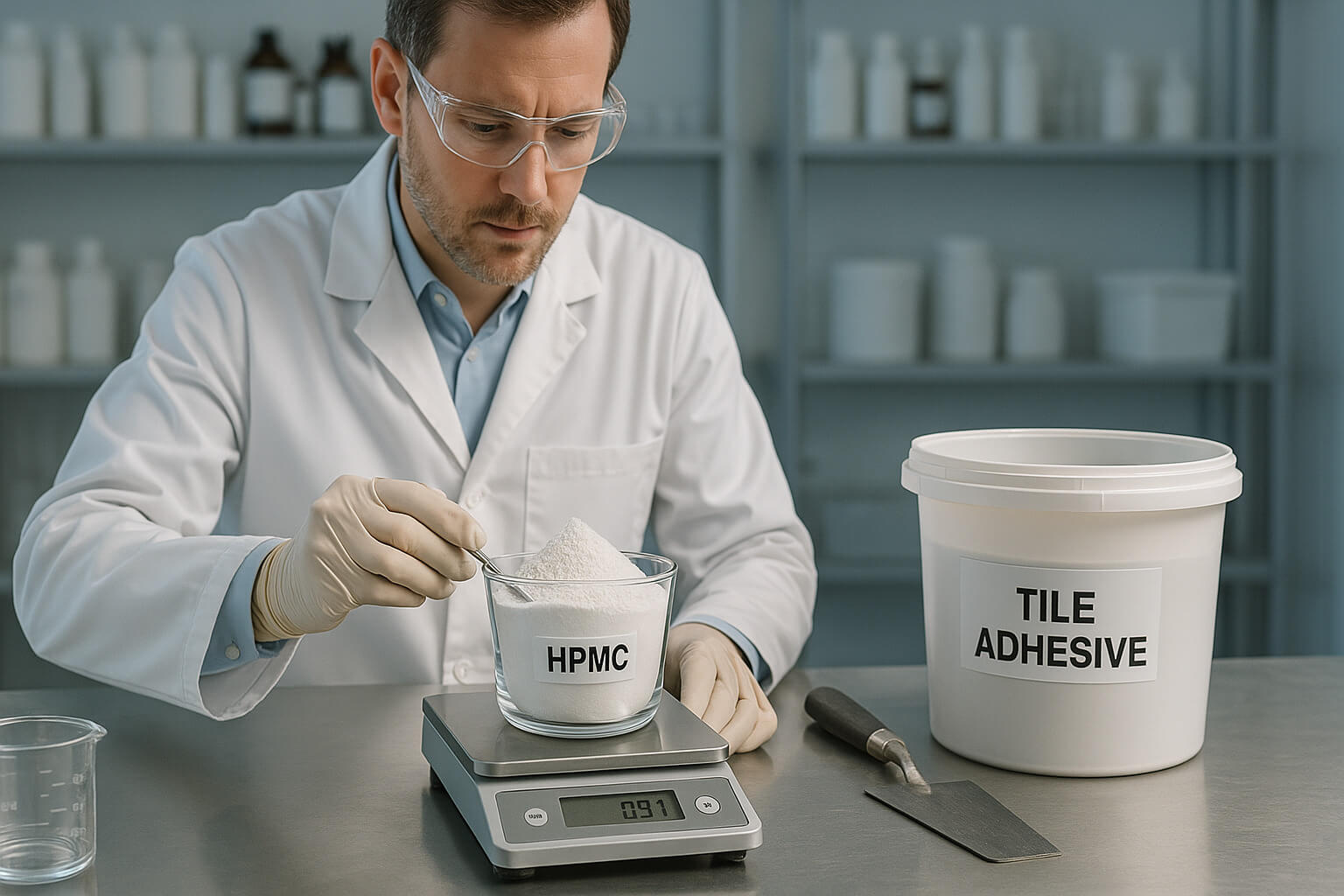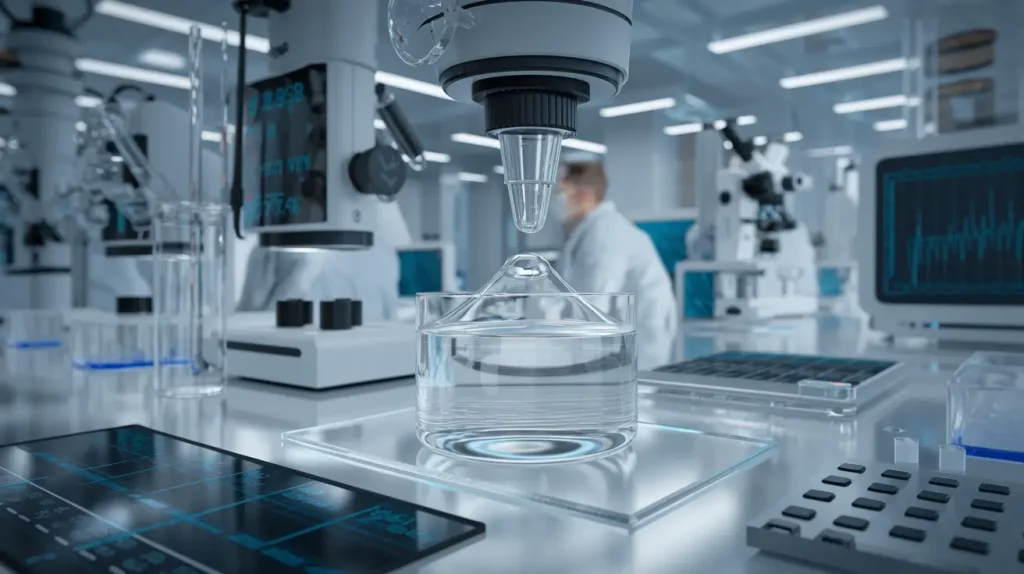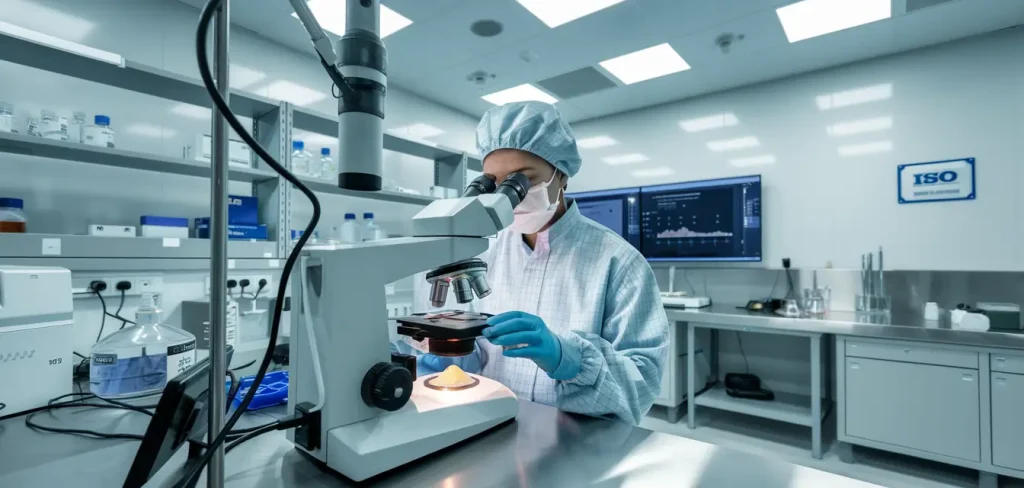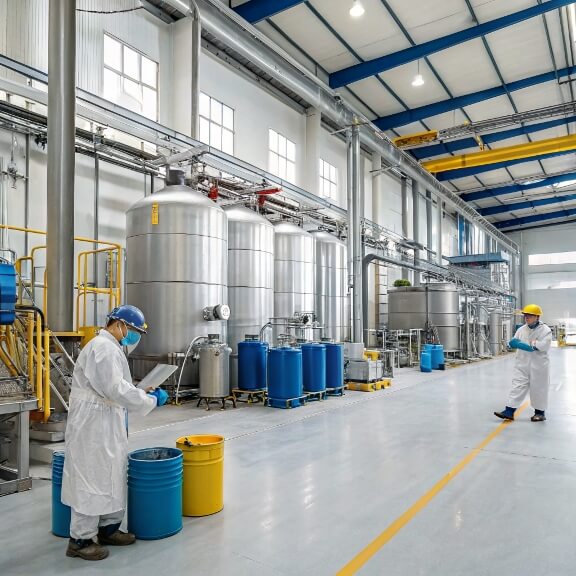Many tile adhesive manufacturers struggle with inconsistent product performance. Even minor formulation errors lead to application failures, customer complaints, and wasted materials.
Hydroxypropyl Methylcellulose (HPMC) dosage in tile adhesives typically ranges from 0.2% to 0.5% by weight of dry mixture, with precise amounts determined by desired performance characteristics including open time requirements, application conditions, substrate porosity, and complementary additive interactions.

A laboratory technician carefully weighing HPMC powder for incorporation into a tile adhesive formulation, demonstrating the precision required for optimal performance.
Finding the right HPMC dosage balance requires technical expertise that most resources don't provide. Let's explore the specific guidelines that ensure consistent tile adhesive performance while optimizing your formulation costs.
What is HPMC and why is it crucial for tile adhesive?
Poorly formulated tile adhesives dry too quickly, fail to bond properly, or sag during vertical applications. These performance issues create installation failures and damage professional reputations.
HPMC (Hydroxypropyl Methylcellulose) functions as a critical water retention agent and rheology modifier in tile adhesives, extending open time from minutes to hours while simultaneously enhancing cohesion, preventing sagging, and improving adhesion through optimal consistency control.
Through our decade of manufacturing experience, we've observed how HPMC transforms basic cement mixtures into professional-grade adhesives. The fundamental chemistry behind this transformation involves HPMC's unique molecular structure, which contains both hydrophilic and hydrophobic segments. When dispersed in water, these segments create a three-dimensional network throughout the adhesive mixture.
This molecular network performs several critical functions simultaneously. First, it physically binds water molecules through hydrogen bonding, dramatically slowing evaporation and migration into porous substrates. This water retention capability directly extends the crucial open time during which tiles can be successfully placed and adjusted.
Beyond water retention, HPMC significantly modifies adhesive rheology. The polymer network creates thixotropic behavior—the mixture remains stable under gravity but flows easily under applied pressure. This characteristic prevents tile slippage on vertical surfaces while ensuring proper spreading and wetting during application.
The practical importance of these properties becomes evident during installation. Without HPMC, most cement-based adhesives remain workable for only 5-10 minutes before surface skinning occurs. This brief window creates tremendous pressure on installers, often leading to improper tile placement or inadequate coverage. HPMC extends this critical period to 20-30 minutes or longer, allowing methodical, precise installation.
HPMC also dramatically improves adhesive cohesion—the internal strength that prevents separation within the adhesive layer itself. This enhanced cohesion translates directly to stronger bonds between tiles and substrates. Our laboratory testing consistently demonstrates that optimized HPMC formulations increase tensile adhesion strength by 15-30% compared to unmodified systems.
The water retention properties prove particularly valuable when installing over porous substrates like unprimed drywall or dry concrete. These materials can rapidly extract moisture from adhesives, compromising hydration and bond development. HPMC creates a protective barrier that maintains adequate moisture within the adhesive layer, ensuring proper cement hydration regardless of substrate conditions, as documented by cement chemistry researchers.
Without this crucial additive, modern thin-set installation methods would be significantly less reliable, particularly for large-format tiles and critical applications like exterior or wet-area installations.
How does HPMC dosage impact tile adhesive performance?
Finding the perfect balance between extended open time and timely final set challenges many formulators. Too little HPMC provides inadequate working time, while excessive amounts delay curing and reduce strength.
HPMC dosage creates a direct, progressive impact on key performance metrics with each 0.1% increase extending open time by approximately 5-10 minutes, enhancing sag resistance by 15-20%, and improving water retention by 10-15%, while excessive levels beyond 0.7% risk delayed setting and potentially reduced final strength.
Our production experience has given us unique insight into the dose-response relationship between HPMC concentration and adhesive performance. This relationship follows predictable patterns across multiple performance parameters, though the exact numbers vary slightly depending on specific HPMC grades and complementary additives.
The most immediately noticeable impact concerns open time. Laboratory testing shows a near-linear relationship between HPMC concentration and working time extension. Starting from an unmodified baseline of approximately 5-10 minutes, each 0.1% HPMC addition typically extends this window by 5-10 minutes. This progressive extension continues until reaching extremely high dosages (>0.8%), where diminishing returns and potential performance trade-offs begin to appear.
Water retention capacity follows a similar pattern but with a more pronounced initial impact. Even at minimal dosages (0.1-0.2%), HPMC significantly improves water retention compared to unmodified adhesives. This relationship continues positively through the standard dosage range before plateauing at higher concentrations where maximum water retention (95-98%) has been achieved.
Sag resistance demonstrates a particularly strong response to HPMC concentration. Our testing shows that properly integrated HPMC dramatically improves vertical hold characteristics, with performance improvements of 15-20% per 0.1% dosage increase within the standard range. This property proves especially valuable for wall tile installations where preventing slip during setting is critical.
The relationship between HPMC dosage and final adhesive strength follows a more complex pattern. Within the optimal range (0.2-0.5%), HPMC generally contributes positively to ultimate bond strength by ensuring complete cement hydration. However, at excessive concentrations (>0.7%), extended setting times may actually reduce final strength by disrupting normal crystal development within the cement matrix.
Workability and consistency also respond predictably to dosage adjustments. Higher HPMC concentrations create richer, more cohesive mixtures that spread easily while maintaining shape after troweling. This improved handling translates directly to better substrate coverage and more successful installations.
It's worth noting that these performance relationships don't exist in isolation. The overall adhesive formulation—particularly cement type, aggregate gradation, and complementary polymer content—influences how dramatically HPMC dosage affects each parameter. This interaction highlights the importance of holistic formulation approaches rather than single-component optimization, as materials science researchers studying construction chemicals have noted.
What are the standard HPMC dosage guidelines for tile adhesive?
Generic dosage recommendations often lead to suboptimal formulations. Without application-specific guidelines, adhesives may perform inconsistently across different installation scenarios.
Standard HPMC dosage guidelines establish 0.3-0.4% as the optimal range for general-purpose tile adhesives, while specialized applications require adjustments: vertical applications benefit from 0.4-0.5%, rapid-setting formulations utilize 0.2-0.3%, and exterior installations typically require 0.3-0.5% depending on expected weather conditions.
| Tipo de adhesivo para baldosas | Recommended HPMC Dosage Range | Key Performance Targets | Aplicaciones comunes |
|---|---|---|---|
| Standard Interior | 0.3-0.4% | Balanced open time (20-30 min) | General wall and floor tiling |
| Vertical/Non-sag | 0.4-0.5% | Enhanced slip resistance (<0.5mm) | Wall tiling, heavy tiles |
| Rapid Setting | 0.2-0.3% | Moderate open time with faster final set | Time-critical installations |
| Tiempo de apertura extendido | 0.4-0.6% | Maximum working time (>40 min) | Complex patterns, large areas |
| Exterior/Weather Resistant | 0.3-0.5% | Balanced with enhanced durability | Outdoor applications, freeze-thaw areas |
| Large Format Tile | 0.4-0.5% | Extended adjustment time, high consistency | Tiles larger than 30×30 cm |
Our manufacturing operations supply HPMC to tile adhesive producers worldwide, giving us comprehensive data on optimal dosage ranges across various application scenarios. These guidelines reflect both laboratory testing and real-world performance feedback from professional installers.
For standard interior applications—the most common use case representing approximately 60-70% of the market—the optimal dosage range typically falls between 0.3-0.4% of the total dry mixture weight. This range provides sufficient open time (20-30 minutes) for methodical installation while allowing final setting within a reasonable period to permit grouting within 24 hours.
Vertical applications demand enhanced slip resistance to prevent tile movement during the critical setting period. For these applications, dosages trend toward the higher end of the spectrum (0.4-0.5%) to create stronger gel structures within the adhesive. This increased dosage significantly improves holding power on vertical surfaces while maintaining workability.
Conversely, rapid-setting adhesives—designed for time-sensitive installations—typically utilize lower HPMC concentrations (0.2-0.3%) while incorporating setting accelerators to balance working time with quicker final hardening. This combination provides just enough open time for proper installation while speeding overall project completion.
Extended open time formulations represent a specialized category for large-scale installations or complex pattern work. These systems employ higher HPMC dosages (0.4-0.6%) specifically to maximize working time, sometimes extending beyond 40 minutes. Such formulations prove particularly valuable for single-installer projects covering substantial areas.
Environmental considerations also influence optimal dosage recommendations. Exterior installations face more demanding conditions including temperature fluctuations, direct moisture exposure, and freeze-thaw cycles. These applications generally require moderate to high HPMC concentrations (0.3-0.5%) combined with specialized polymers to achieve necessary durability.
Large-format tile installation—an increasingly common application—presents unique challenges requiring specific dosage considerations. The extended surface area creates greater suction against the substrate, demanding adhesives with excellent water retention. Dosages for these applications typically range from 0.4-0.5% to maintain proper consistency throughout the extended bedding and adjustment process.
These standard guidelines serve as starting points rather than absolute rules. Specific product requirements, regional preferences, and manufacturer capabilities may necessitate adjustments. Our technical team regularly helps customers fine-tune formulations based on their particular constraints and performance targets while following industry-established best practices for tile installation materials, as recommended by tile council technical committees.
How do formulation variables affect the ideal HPMC percentage?
Formulation adjustments often necessitate HPMC recalibration. Changes in cement content, polymer additions, or aggregate profiles create interaction effects that impact optimal HPMC levels.
Key formulation variables influencing optimal HPMC dosage include cement ratio (higher cement typically requires increased HPMC), complementary polymer content (may allow reduced HPMC), aggregate fineness (finer aggregates interact more extensively with HPMC), and accelerator/retarder presence which necessitates proportional HPMC adjustments.
Through our manufacturing operations and technical support services, we've developed detailed understanding of how various formulation components interact with HPMC. These interactions follow predictable patterns that help guide dosage adjustments when modifying tile adhesive compositions.
Cement content represents one of the most significant variables affecting optimal HPMC dosage. Higher cement concentrations typically require proportionally increased HPMC to maintain proper water retention and working time. This relationship stems from cement's natural tendency to rapidly consume water during hydration. Our testing shows that formulations with cement content above 35% may require HPMC increases of 0.05-0.1% beyond standard recommendations to maintain consistent performance.
Complementary polymers, particularly redispersible polymer powders (RPP), create important interaction effects with HPMC. These materials often provide additional water retention capabilities through different mechanisms. When formulations contain substantial RPP additions (typically 2-4%), HPMC dosage can sometimes be reduced by 0.05-0.1% while maintaining overall performance. This synergistic relationship allows formulators to optimize the cost-performance balance of their adhesive systems.
Aggregate characteristics significantly influence HPMC behavior within the adhesive matrix. Finer aggregate profiles with higher specific surface areas interact more extensively with HPMC, sometimes reducing its effective concentration. Conversely, coarser aggregates may require slightly higher HPMC dosages to achieve equivalent water retention. The mineralogical composition of the aggregate also matters—some minerals interact more strongly with HPMC through surface charge effects that can either enhance or diminish its effectiveness.
Setting modifiers create particularly important considerations for HPMC dosage. Accelerators like calcium formate, which speed set time, often necessitate increased HPMC concentration to maintain adequate working time. Conversely, retarders may allow slight HPMC reductions without compromising performance. These adjustments require careful balancing to avoid unexpected interactions between the different additives.
Production method influences optimal dosage as well. Dry-mix manufacturing processes sometimes suffer from HPMC distribution challenges that reduce effective concentration in the final mixture. Production facilities using high-efficiency mixers typically achieve better HPMC distribution, allowing them to use the lower end of the recommended dosage range while maintaining performance.
Regional climate conditions where the product will be used should also factor into dosage decisions. Adhesives destined for hot, dry environments generally benefit from higher HPMC concentrations (closer to 0.5%) to compensate for accelerated drying conditions. Products for cooler, more humid regions can often utilize lower dosages (0.2-0.3%) without compromising performance.
The cement type itself creates another significant variable. Fast-setting cements typically require higher HPMC dosages to provide adequate working time. Portland cement Type III, for example, generally needs approximately 0.05-0.1% more HPMC compared to Type I for equivalent open time performance.
Understanding these interaction effects allows formulators to make intelligent adjustments rather than simple trial-and-error modifications. Our laboratory regularly conducts multi-factorial experiments to map these relationships for specific construction applications, helping our customers develop optimized systems with precisely tailored HPMC dosages.
How do you measure and mix HPMC correctly in tile adhesive production?
Improper HPMC incorporation leads to manufacturing inconsistencies. Lumps, poor dispersion, and inadequate hydration create quality control problems and performance variations.
Correct HPMC incorporation requires precise measurement using calibrated equipment, thorough pre-blending with dry components before water addition, careful temperature control during mixing, and sufficient mixing time (typically 3-5 minutes dry, 5-7 minutes wet) to ensure complete dispersion throughout the adhesive matrix.
Our experience supporting tile adhesive manufacturers has highlighted the critical importance of proper measurement and incorporation techniques. These processes directly impact final product performance and consistency regardless of formulation quality.
Accurate measurement forms the foundation of proper HPMC incorporation. Given the relatively low usage rates (0.2-0.5%), even small measurement errors can significantly impact performance. Professional manufacturing operations should utilize precision scales with resolution of at least 0.01% of the batch weight. For a typical 1000kg production batch, this means measurement accuracy within 100g.
Beyond measurement precision, proper HPMC dispersion within the dry mixture proves equally crucial. The most effective approach involves a two-stage mixing process:
- Pre-blend HPMC with a portion of fine aggregates or fillers (10-20 times the HPMC weight)
- Introduce this pre-blend into the main mixer containing remaining dry components
- Mix dry components thoroughly (3-5 minutes minimum) before water addition
- Add water gradually while continuing mixing to ensure uniform hydration
- Continue mixing for 5-7 minutes after water addition to achieve complete hydration
This approach prevents the formation of gel lumps that occur when HPMC contacts water directly. The pre-blending step physically separates HPMC particles, allowing each to hydrate individually rather than forming agglomerates that resist complete integration.
Water temperature significantly impacts HPMC dissolution and performance. Our laboratory testing shows optimal hydration occurs between 15-25°C (59-77°F). Colder water can delay proper viscosity development, while warmer water may cause premature gelation before adequate dispersion occurs. Production facilities should monitor and control water temperature, particularly during seasonal weather changes.
The mixing equipment itself influences HPMC incorporation effectiveness. High-shear mixers generally achieve better dispersion compared to simple paddle mixers. For operations using lower-efficiency equipment, we typically recommend:
- Slightly longer mixing times
- More extensive pre-blending with dry components
- Potential use of more easily dispersible HPMC grades
Batch size consistency also affects HPMC performance. Manufacturing operations should standardize batch sizes to maintain consistent ingredient ratios and mixing dynamics. Variable batch sizes can create unexpected changes in mixing efficiency that impact HPMC dispersion quality.
Quality control procedures should include specific checks for proper HPMC incorporation. Visual inspection for gel lumps provides basic verification, while simple water retention tests offer more quantitative assessment. Establishing standard testing protocols helps maintain consistent product performance across production runs.
For continuous production processes, special consideration must be given to HPMC feeding systems. Volumetric feeders should be regularly calibrated to ensure accurate dosing, with particular attention to potential bridging issues that can occur with some HPMC grades.
Some manufacturers find that certain HPMC grades disperse more readily than others despite similar viscosity specifications. Our production team can recommend specific grades optimized for different manufacturing processes, helping minimize incorporation challenges while maintaining final performance properties.
Proper storage and handling procedures further support successful HPMC incorporation. The material should be protected from moisture exposure before use, as partial hydration can significantly impact dispersion behavior and final product performance.
What mistakes should be avoided when using HPMC in tile adhesives?
Even experienced formulators make critical errors when working with HPMC. These mistakes compromise product quality, increase manufacturing costs, and create field performance problems.
The most detrimental HPMC usage mistakes include incorrect viscosity grade selection, inadequate dry pre-blending, improper environmental testing, overreliance on open time at the expense of final set, and mismatched HPMC chemistry with environmental conditions or complementary additives.
Common Technical Errors
Through our technical support activities with adhesive manufacturers worldwide, we've identified several recurring mistakes that significantly impact product quality. Understanding and avoiding these errors can dramatically improve both manufacturing efficiency and final performance reliability.
The most fundamental error involves selecting inappropriate HPMC viscosity grades for specific applications. Some manufacturers choose grades based solely on cost considerations rather than performance requirements. Low-viscosity grades (15,000-30,000 mPa·s) often provide inadequate water retention for demanding applications, while extremely high viscosity types (>150,000 mPa·s) can create mixing difficulties and excessive set delays. Proper selection requires matching viscosity to specific application needs.
Poor dry-mixing procedures create another common pitfall. Some producers add HPMC directly to water or introduce it insufficiently blended into the wet mixture. This approach invariably creates gel lumps that never fully integrate, leading to inconsistent performance across the applied area. Thorough pre-blending with dry components before water addition remains essential for optimal dispersion.
Environmental testing oversights frequently lead to field performance problems. Many manufacturers test products only under standard laboratory conditions (23°C/73°F, 50% RH) without evaluating performance across the full range of installation environments. HPMC behavior changes significantly with temperature and humidity variations, making comprehensive environmental testing crucial for reliable products.
Another common mistake involves focusing exclusively on open time without considering final setting behavior. While extended working time benefits installation, excessive delays in final hardening can prevent timely project completion and grouting. Balancing these properties requires careful consideration of both HPMC type and dosage within the complete formulation context.
Ignoring substrate interaction effects creates application problems that may not appear during laboratory testing. HPMC performance varies significantly between porous and non-porous substrates. Manufacturers should evaluate water retention on both standard concrete substrates and highly absorbent materials like unprimed drywall to ensure adequate performance across applications.
Manufacturing Process Errors
Beyond formulation issues, we've observed several manufacturing process errors that compromise product quality:
- Inadequate mixing time following water addition
- Improper storage of HPMC (exposure to high humidity)
- Inconsistent water temperature between production batches
- Variable water quality affecting HPMC hydration
- Insufficient quality control testing focused on water retention
Manufacturing facilities should establish standardized procedures addressing these variables. Simple process controls—like water temperature monitoring, consistent mixing times, and regular water retention testing—can dramatically improve batch-to-batch consistency.
Application Errors
Even perfectly manufactured products can fail due to application errors. Common field mistakes include:
- Using excessive water during mixing
- Applying over unsuitable substrates without proper preparation
- Installing in extreme temperature conditions
- Exceeding the adhesive's open time capability
- Insufficient coverage due to improper troweling technique
Manufacturers should provide clear application guidelines addressing these potential issues. Technical data sheets should specify temperature limitations, open time expectations, and substrate preparation requirements to prevent installation failures.
To avoid these common errors, manufacturers should implement comprehensive quality systems that address both formulation and processing factors. Regular testing under varied conditions helps identify potential performance issues before they create field problems. Our technical service team has helped many customers develop testing protocols aligned with industry standards to ensure reliable, consistent performance across production lots.
Preguntas frecuentes
¿Qué es HPMC para mosaico?
HPMC for tiling is a cellulose-based polymer that functions as a critical water retention agent and rheology modifier in tile adhesives. It works by forming a protective gel network throughout the adhesive that slows water evaporation and prevents excessive absorption into porous substrates. This water retention capability extends open time from typically 5-10 minutes to 20-30 minutes or longer, allowing proper tile placement and adjustment. HPMC also enhances adhesive consistency, improves vertical non-sag properties, and promotes better tile wetting for stronger bonds.
What is a cement-based tile adhesive?
A cement-based tile adhesive is a specially formulated dry mortar containing Portland cement, graded aggregates, and performance additives that creates a permanent bond between tiles and substrates when mixed with water. Unlike traditional mortars, these adhesives contain precisely balanced additives like HPMC and polymers that enhance workability, extend open time, and improve adhesion strength. They typically achieve bond strengths exceeding 1 MPa after curing while providing sufficient working time for proper installation. These materials cure through cement hydration rather than simple drying, resulting in moisture-resistant bonds suitable for both interior and exterior applications.
¿Qué es HPMC para mortero Drymix?
HPMC for Drymix mortar functions as a multifunctional additive that enhances water retention, workability, and adhesion properties in pre-blended cement mixtures. In mortar applications, HPMC dosage typically ranges from 0.1% to 0.4% of the dry formulation, with specific grades selected based on required open time and consistency. It creates a balanced rheology that maintains workability without excessive flow while significantly extending the mixture's usable life. HPMC also improves mortar cohesion during application and enhances bonding to various substrates, making it essential for both masonry and rendering applications.
Can you mix adhesive and cement?
Mixing pre-formulated adhesive with additional cement is generally not recommended as it disrupts the carefully balanced chemistry of the original formulation. Adding cement typically alters the water-to-cement ratio, potentially causing reduced workability, shortened open time, and compromised adhesion strength. For specific applications requiring modified properties, we recommend selecting a purpose-formulated product rather than field modification. If adjustment is absolutely necessary, consult the adhesive manufacturer for guidance—some systems can tolerate minor cement addition (5-10% maximum) when additional strength is required, but this should be approached with caution.
Conclusión
Proper HPMC dosage serves as the foundation for high-performance tile adhesives, with the optimal range of 0.2-0.5% providing the ideal balance between extended working time and final strength development. This relatively narrow window requires precise measurement and incorporation techniques to achieve consistent results.
Our manufacturing experience has demonstrated that successful HPMC implementation demands a systematic approach—understanding the dosage-response relationship, selecting appropriate grades for specific applications, and implementing proper production processes. When correctly utilized, HPMC transforms basic cement mixtures into professional-grade adhesives with the perfect balance of workability and performance.
For adhesive manufacturers seeking to optimize their formulations or solve specific performance challenges, contact our technical team at Morton for personalized HPMC recommendations based on your exact application requirements, manufacturing capabilities, and regional installation conditions.




